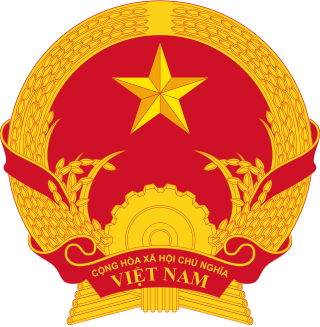
The politics of Vietnam is dominated by a single party, the Communist Party of Vietnam (CPV). The President of Vietnam is the head of state, and the Prime Minister of Vietnam is the head of government, both of these are separate from the General Secretary of the Communist Party of Vietnam who leads the Communist Party and is head of the Politburo and the Central Military Commission, thus the General Secretary is the de facto supreme leader of Vietnam. Executive power is exercised by the government and the President of Vietnam. Legislative power is vested in the National Assembly of Vietnam. The Judiciary is independent of the executive. The parliament adopted the current Constitution of Vietnam, its fifth, on 28 November 2013.

The Constitution of the People's Republic of China is the supreme law of the People's Republic of China. It was adopted by the 5th National People's Congress on December 4, 1982, with further revisions about every five years. It is the fourth constitution in PRC history, superseding the 1954 constitution, the 1975 constitution, and the 1978 constitution.

A communist state, also known as a Marxist–Leninist state, is a one-party state that is administered and governed by a communist party guided by Marxism–Leninism. Marxism–Leninism was the state ideology of the Soviet Union, the Comintern after Bolshevisation and the communist states within the Comecon, the Eastern Bloc, and the Warsaw Pact. Marxism–Leninism currently still remains the ideology of a few parties around the world. After its peak when many communist states were established, the Revolutions of 1989 brought down most of the communist states, however, it is still the official ideology of the ruling parties of China, Cuba, Laos, and Vietnam. During most of the 20th century, before the Revolutions of 1989, around one-third of the world's population lived under communist states.

The Constitution of East Germany refers to the constitution of the German Democratic Republic, commonly known as East Germany. Its original constitution was promulgated on 7 October 1949. It was heavily based on the "Weimarer Reichsverfassung", and nominally established the GDR as a liberal democratic republic. In 1968 the East German government adopted a new, fully Communist constitution that was based on Marxism-Leninism, political unitarism, and collective leadership. There were further amendments to the 1968 constitution in 1974. With the political events of 1989, there were attempts to draft a new constitution for East Germany, but these efforts never materialized due to the dissolution of East Germany and the accession of its Länder into the neighboring Federal Republic.
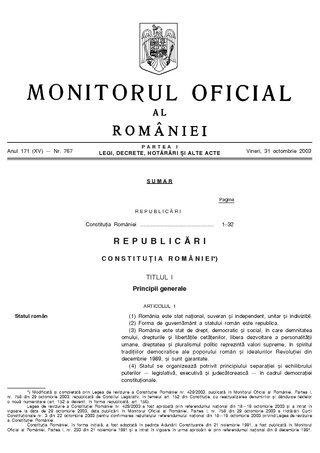
The current Constitution of Romania is the seventh permanent constitution in modern Romania's history. It is the fundamental governing document of Romania that establishes the structure of its government, the rights and obligations of citizens, and its mode of passing laws. It stands as the basis of the legitimacy of the Romanian government. Adopted on 21 November 1991, it was approved on 8 December 1991 in a national referendum and promulgated on the same day.
The 1936 Constitution of the Soviet Union, also known as the Stalin Constitution, was the constitution of the Soviet Union adopted on 5 December 1936.
The 1977 Constitution of the Soviet Union, officially the Constitution of the Union of Soviet Socialist Republics, was the constitution of the Soviet Union adopted on 7 October 1977 until its dissolution on 21 December 1991. Also known as the Brezhnev Constitution or the Constitution of the Developed Socialism, it was the third and final constitution of the Soviet Union, adopted unanimously at the 7th (Special) Session of the Ninth Convocation of the Supreme Soviet and signed by Leonid Brezhnev. The 1977 Constitution replaced the 1936 Constitution and introduced many new rights and duties for citizens along with rules governing the republics within the union.

The Constitution of the Czechoslovak Socialist Republic, promulgated on 11 July 1960 as the constitutional law 100/1960 Sb., was the third constitution of Czechoslovakia, and the second of the Communist era. It replaced the 1948 Ninth-of-May Constitution and was widely changed by the Constitutional Law of Federation in 1968. It was extensively revised after the Velvet Revolution to prune out its Communist character, with a view toward replacing it with a completely new constitution. However, this never took place, and it remained in force until the dissolution of Czechoslovakia in 1992.

The Constitution of the Socialist Republic of Vietnam is the current constitution of Vietnam, adopted on 28 November 2013 by the Thirteenth National Assembly, and took effect on 1 January 2014. It is the fourth constitution adopted by the Vietnamese government since the political reunification of the country in 1976.

The present Constitution of Portugal was adopted in 1976 after the Carnation Revolution. It was preceded by a number of constitutions including the first one created in 1822, 1826, 1838, 1911, and 1933.
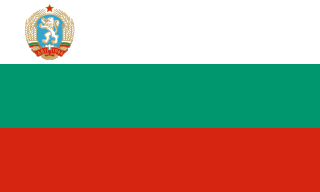
The People's Republic of Bulgaria, from 1990-1990 known as Republic of Bulgaria, was the official name of Bulgaria, when it was a socialist republic from 1946 to 1990, ruled by the Bulgarian Communist Party (BCP) together with its coalition partner, the Bulgarian Agrarian People's Union. Bulgaria was closely allied and a satellite state of the Soviet Union during the Cold War, being part of Comecon as well as a member of the Warsaw Pact. The Bulgarian resistance movement during World War II deposed the Kingdom of Bulgaria administration in the Bulgarian coup d'état of 1944 which ended the country's alliance with the Axis powers and led to the People's Republic in 1946.

The Parliament of Romania is the national bicameral legislature of Romania, consisting of the Chamber of Deputies and the Senate. It meets at the Palace of the Parliament in Bucharest, the capital of the country.

The Great National Assembly was the legislature of the Socialist Republic of Romania. After the overthrow of Communism in Romania in December 1989, the Great National Assembly was dissolved by decree of the National Salvation Front (FSN) and eventually replaced by the bicameral parliament, made up of the Chamber of Deputies and the Senate.
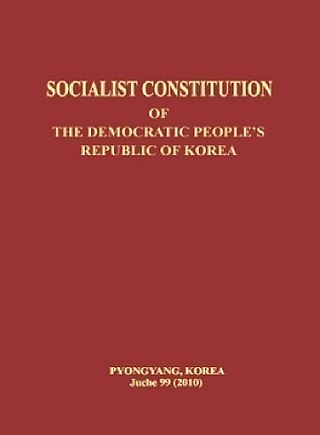
The Socialist Constitution of the Democratic People's Republic of Korea is the constitution of North Korea. It was approved by the 6th Supreme People's Assembly at its first session on 27 December 1972, and has been amended and supplemented in 1998, 2009, 2012, 2013, 2016 and twice in 2019. It replaced the country's first constitution which was approved in 1948.

The 1952 Constitution of Romania, also called the "constitution of building socialism", expressed the consolidation of Communist power, featuring greater ideological content than its 1948 predecessor. A draft was written by a commission elected by the Great National Assembly on March 27, 1952, and published on July 18. By a 324-0 vote, it was adopted by the Great National Assembly on September 24, when it came into force, and published three days later.
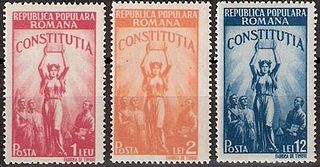
The 1948 Constitution of Romania was the first adopted after the establishment of the Communist regime, which it enshrined into law. It was modelled on the 1936 Soviet Constitution and adopted by the Great National Assembly (MAN) on April 13, 1948, being published in Monitorul Oficial the same day. The Romanian People's Republic was defined as a “unitary and sovereign people's state” that “came into being through a struggle led by the people, the working class at their head, against fascism, reaction and imperialism”.

The nationalization of the means of production was a measure taken by Romania's new Communist authorities in order to lay the foundation of socialism. The act that allowed this measure to take place was Law 119, adopted by the Great National Assembly on June 11, 1948. Article 1 decreed subject to nationalization "all the wealth of the soil not in the property of the state at the time of entry into force of the Constitution of the Romanian People's Republic, as well as individual enterprises, societies of any type and private industrial, bank, insurance, mining, transport and telecommunications associations". Nationalized were 8,894 industrial, mining, transport, banking and insurance companies, followed in November 1948 by 383 cinemas and medical-sanitary facilities. By 1950, the measure was applied to chemical enterprises, pharmacies and remaining economic entities.

The Constitution of Laos specifies the functions and powers of the government of the Lao People's Democratic Republic, and defines the rights and duties of Laotian citizens. The constitution was adopted on August 14, 1991, sixteen years after the 1975 establishment of the Republic, a period during which the country functioned without a written constitution or published penal and criminal codes. It consists of a Preamble and Articles, and legally establishes a set of authorities that resemble the traditional differentiation among executive, legislative, and judicial branches of government.

The 1974 Yugoslav Constitution was the fourth and final constitution of the Socialist Federal Republic of Yugoslavia. It came into effect on 21 February 1974.
The Ukrainian Soviet Socialist Republic, part of the Soviet Union, had four successive constitutions during its existence. The first (1919) was in Russian and the final three were in Ukrainian.














